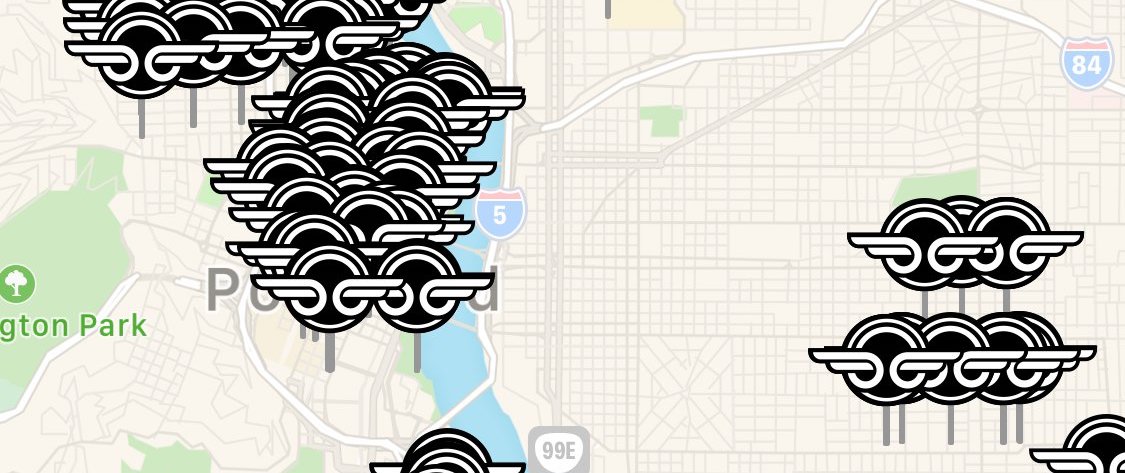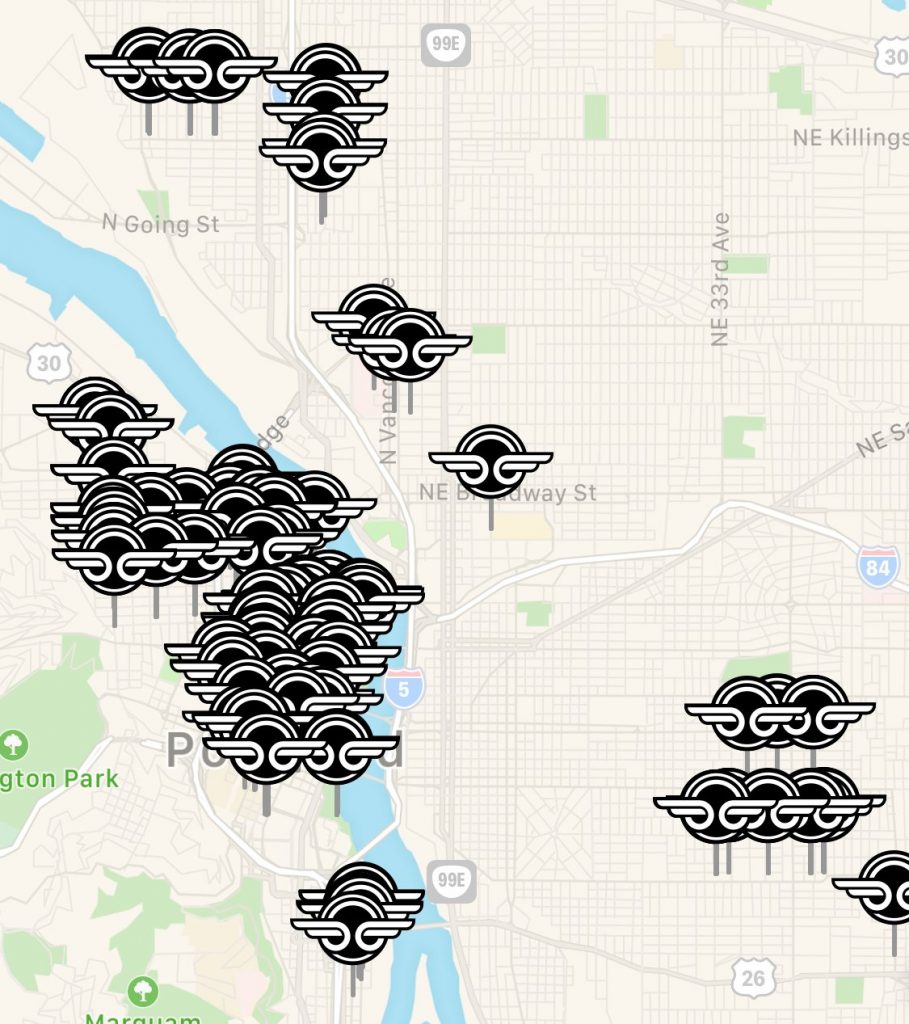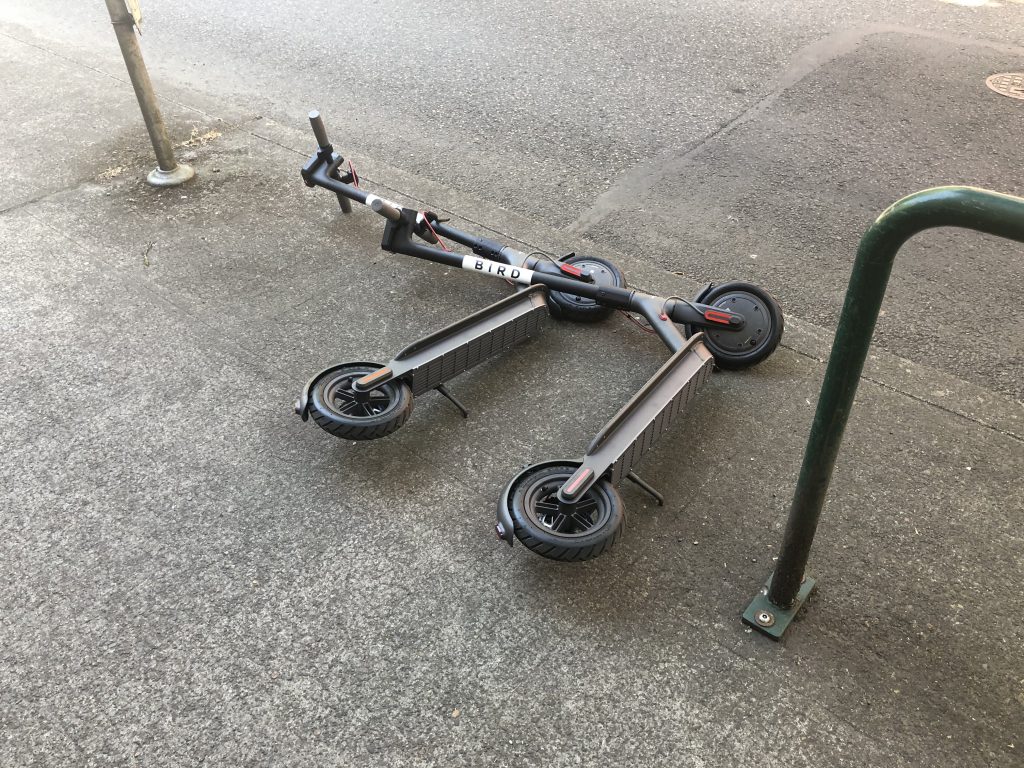Portland is such a great transportation city. We have a lightrail system that’s been around since the 70s. We have a great fleet of buses and some streetcars. We have all of these connected to Open Data pipes that allow third parties to innovate with transit trackers. We have smartphone apps and not-quite-Oyster cards that let you hop on any of these without thinking too hard about exact change. We used to have the best bike infrastructure in the US — until Austin beat us out. Sure, it doesn’t match, say, Amsterdam, but it’s pretty darn good for a US city. And we have a healthy and skeptical fear of Bay Area scooters.
The scooters started in San Francisco, but they’re now banned there. They’re “disruptive technology” in the same way that Uber was. They swept in without regard to local laws or even common courtesy. Find a scooter wherever, using GPS on your smartphone, rent it, then drop it off wherever. In this case “wherever” tended to be in the middle of the sidewalk, in the middle of the bike lane, in front of a shop door, and generally places that are not only an annoyance and tripping-hazard, but actively bad for anyone with a disability. They lock when nobody’s actively renting them, but they’re scooters. They’re lightweight. You can pick them up. So they scream annoyingly if you try to move them. Local residents of SF got annoyed at tech-bros leaving their toys on the sidewalk to trip on and started doing things like throwing them in dumpsters, throwing them in pools and fountains, throwing them from atop buildings, and even lighting them on fire. See also the Instagram account chronicling the scooter vandalism.
So Portland, rightfully, is taking things slowly. And the scooter companies are — surprisingly — playing along and not just pulling an above-the-law Uber entitlement. They’ve been working on a pilot program that just kicked off today with Bird and Skip. Portland is taking a pretty sizable chunk of tax from these companies — 25¢ from each ride, with the rides costing a baseline $1 + 15¢/minute — and investing that into the infrastructure that bicycles and scooters share. This seems like a win for everyone.
I work at the south end of downtown — near Portland State University. One of my favorite restaurants is at the north end of downtown — Mi Mero Mole. It’s a bit far to go on a lunch hour, unless you perfectly time the Max trains. Since this was the first day of eScooters, and since there were a ton of them downtown, I enlisted a coworker and figured we should give them a try.
The [initial] signup was simple. Download the Bird app, set your name, verify your email, and optionally add a picture. You then link a payment source — credit card or Apple Pay. There’s a short slideshow that teaches you how to check out a scooter and reminds you of the appropriate local laws. Getting a scooter is easy. Find one in the app, walk to it, and scan the barcode. The laws are fairly straightforward. It’s like a bike. Use bike lanes when available. Don’t use the sidewalk. Wear a helmet. I think the helmet part is going to be the most contentious part of it all. Technically, adults on a bike don’t need a helmet here, but they are required on a scooter. I was fortunate because I biked into work today and happened to have my helmet with me. There will be many times where I will want to take a scooter spontaneously and will not have thought to bring a helmet. Tourists visiting town will likely not have their own helmets. Bird offers up “free” helmets (with $2 in shipping), which will allow me to keep a spare one at work, but I feel like there’s a lot of opportunity to innovate in the “oops, I didn’t think to bring a helmet with me today” space.
So my buddy and I go out to grab a pair of scooters at lunch. We found a pair of them two blocks away.
Were they on their side on purpose? Did someone get agro and kick them over? Was it the wind? I guess we’ll never know. So we scan the barcode and then…
Oh, hey, it’s app signup phase two! You’re out in the field, ready to go where you need to go, with a tiny smartphone in hand. What better time to present pages and pages and pages of small-print EULA? Literally one of the longest EULAs I’ve seen, with no way to save it, and as far as I can tell now, no way to get back to it. At the bottom were a number of checkboxes you had to tick to agree to company terms and local laws (you’re over 18, you wear a helmet, you park responsibly). Whew. Done with that.
AND THEN. Hey, let’s scan your driver’s license. Wait, what? Snap a photo of my drivers license? I wasn’t expecting that, but I guess I can understand from a liability perspective. It would have been nice to know about this up front, so that this was less of a shock. So that I was more prepared. Let’s scan the barcode on the back, too. Well, okay. I’ve already scanned that myself, eons ago, and know there’s not much hidden in there. Still, it felt — if not quite bait-and-switch — a little weird and awkward, to have this extra sign-up step sprung on me at the time of the first rental, when I’m standing at the scooter with my phone in hand, and not before, when I was comfortably in the office, creating my account, uploading my photo, and looking at the map.
The ride itself was smooth. Those are fun, zippy little vehicles. I had some cognitive issues for the first several blocks. I have an e-bike with the primary (rear) brake as a lever on the right, and a little “turbo boost” switch on the left to help get up to speed after being stopped at a red light. The scooter is exactly the same, but mirror image. I kept grabbing for a nonexistent brake with the wrong hand. It was like being a stick-shift driver in an automatic car. You find your hand reaching for a control that isn’t there — which isn’t so bad for the gear shift, but a little more dangerous with the brake.
At several points both during and after each rides, we ended up as unpaid spokespeople for Bird. These scooters are so new that today was their first day, so people had all sorts of questions about how the system worked. We ended up getting to the restaurant for about $3 each (due to traffic and route choice) and back to the office for about $1.50 (we zipped down Broadway).
Overall, I have to say that it was zippy and fun. It is certainly more cost-effective to keep on the bus or Max, and spontaneity can be hampered by the helmet requirement. But it’s more fun and quick to take the scooter. The bike has its own tradeoffs. I always feel a little nervous about locking up my $1800 eBike in Old Town Chinatown after dark as I hop into the barcade. I’d have zero second thoughts about leaving someone else’s scooter in lock-mode next to those same bike racks. That’s somebody else’s problem.
But overall, I hope these scooters take off and establish a cooperative, symbiotic relationship with the city. I’d hate to see them turn into bay-area above-the-law a-holes. I’d hate to see locals lighting them on fire and throwing them off bridges into the river. I’d love to see them take hold and establish themselves as yet another transportation option. And I’m genuinely excited that they can help pay for even more amazing infrastructure.



